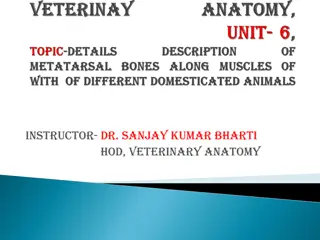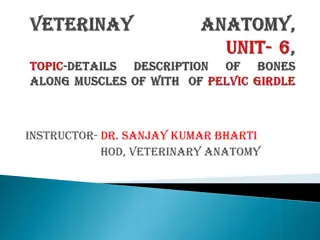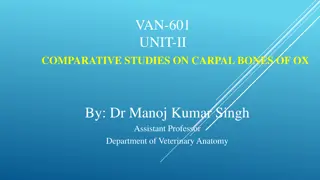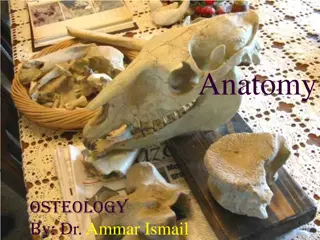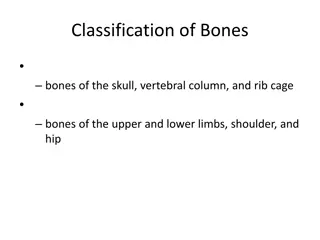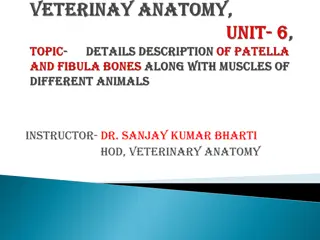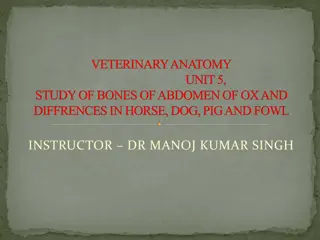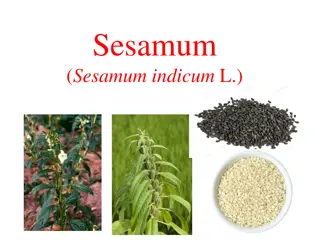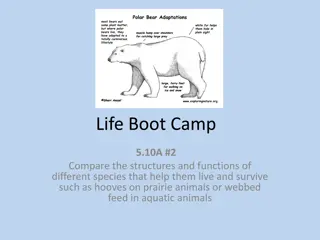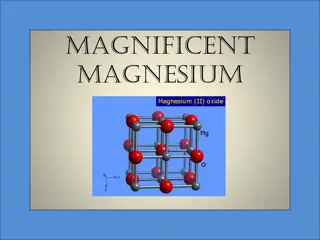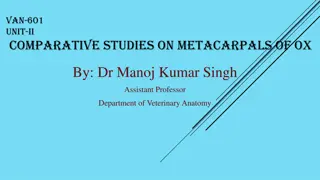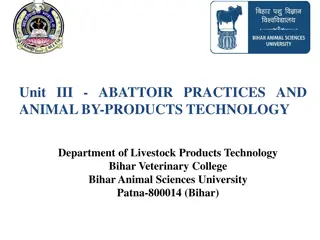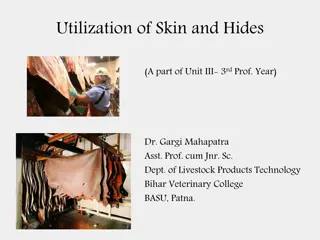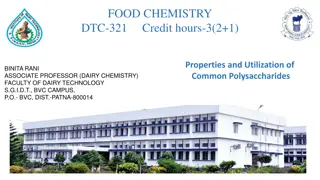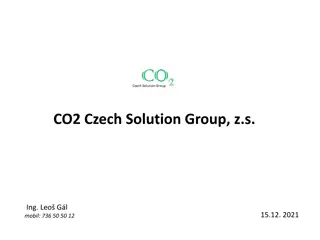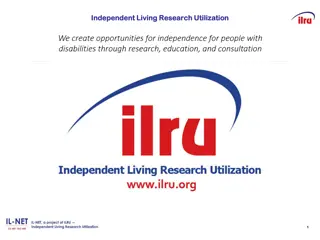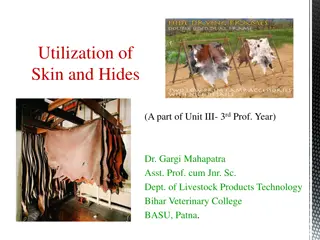Utilization of Bones, Hooves, and Horn from Slaughterhouse Byproducts
Bones, hooves, and horns from slaughterhouse byproducts hold significant value and can be utilized for various purposes. Bones contain organic and inorganic matter, with applications in manufacturing, poultry feeds, and pottery. Hooves and horns contribute to gelatine and glue production, derived from collagen-rich sources such as hides, skins, and bones. Understanding the types of bone and methods of processing is essential for maximizing the potential of these byproducts.
Download Presentation

Please find below an Image/Link to download the presentation.
The content on the website is provided AS IS for your information and personal use only. It may not be sold, licensed, or shared on other websites without obtaining consent from the author. Download presentation by click this link. If you encounter any issues during the download, it is possible that the publisher has removed the file from their server.
E N D
Presentation Transcript
LPT 606: SLAUGHTER HOUSE BYPRODUCTS TECHNOLOGY (2+1) UNIT I UTILIZATION OF BONES, HOOVES, HORN FROM SLAUGHTER HOUSE BYPRODUCTS Dr. R. K. Jaiswal Asstt. Prof.-cum-Jr. Scientist Dept. of Livestock Products Technology Bihar Veterinary College Bihar Animal Sciences University Patna-800014 (Bihar)
Bone Bone constitute almost 15% of the weight of dressed carcass It may vary according to breed, age, health status, etc. On live weight basis, bones form 12-30% in cattle, buffalo and pig; 20-30% in sheep and goat In bone, organic and inorganic matter are in 1:2 ratio Bone collagen (ossein) is main organic constituent Major inorganic matter consists of 33% Calcium- 15% Phosphorus Bone marrow (red and yellow) consists 96% fat
Types of bone Green /fresh bone Freshly acquired bone from slaughter house Heavy and contains high moisture, fat and protein Composition of green bone Moisture: 50% Bone marrow: 15% Organic mater: 12% Inorganic mater: 23%
Desert bone Belongs to fallen animals and decomposed bone Exposed to bacteria, insects and other atmospheric action for long time Devoid of meat, fat and tendon Light in weight and contains only dried ossein, Ca, P and lesser minerals
Uses of bones Manufacture of dice, buttons and knife handles. Today plastic has replaced bones for various purposes To recover different components like fat, protein and inorganic material. Owing to its high calcium and phosphorus content, bone meal is used as a constituent of poultry feeds and as a fertilizer. Calcined bone, obtained by roasting in air, is used in the manufacture of high-class pottery and china, in the refining of silver and in copper smelting.
Raw Materials for gelatine and glue Collagen is 30% of the animal body's total organic matter, or 60% of the animal body's protein. Tissues containing collagen could be extracted for glue and gelatine. e.g. hides or skins (including pigskins) and bones. The other sources, even though feasible, are usually utilized only in small quantities. Contrary to popular opinion hoofs, horns, hair, feathers, and eggshell waste do not yield gelatine.
Methods of bone processing Processing under pressure In this method the bones with all adhering meat and tendons together with other offals are processed under pressure to obtain bone and other meat meal. Boiling bones in open kettle In this method all adhering material is freed by dissolving a small part of the ossein. The bones are then lifted from the boiling liquid and milled to produce raw bone meal.
Boiling bones under pressure In this method the ossein gets free and this protein is used in meat meal production and milling the bones for steamed bone meal. Conserving the ossein for gelatine manufacture By subjecting the bones to prolonged cooking in open vats avoid boiling by not exceeding 87.8 C (190 F). This results in the loss of the fat while preserving the ossein.
Utilization of bone from abattoir Bones contain 33 to 36% of organic substance, bone collagen or ossein, which is the mother substance for gelatine and glue. Gelatine Gelatine can be obtained by boiling ossein or by boiling degraded bones in water acidified with Hydrochloric acid, which separates the gelatinous substances. It is a derived protein of albuminoidal class, which has both edible and inedible (technical) uses.
Edible gelatine is manufactured from fresh bones obtained from slaughtered and inspected animals under strict hygienic conditions. Pure gelatine is an amorphous and transparent substance devoid of any colour, taste and smell. It is brittle when dry, softens on heating and then decomposes with burnt hair smell. It swells in cold water absorbing 5 to 10 times its weight and dissolves on warming up to 30 C.
Glue Glue is the inferior gelatine and is obtained in the same manner as gelatine. It is low-grade gelatine with comparatively dark colour and has only inedible uses. Chemically there is no difference between gelatine and glue. Glue is used as an important adhesive in plywood, furniture, sand paper, gummed tape, etc.
Ossein : It is obtained by breaking the bones in weak acids, which dissolves the mineral components leaving the organic matter.
Steps in bone processing Selection of bones: This process involves selection of mainly six long bones-femur, tibia, metatarsus, humerus, radius and ulna, metacarpus, etc. Cutting : The first is to saw of the knuckles and kneecaps with a power driven circular saw. The cutting is done through the line of the nerve hole, the aim being to expose the marrow to the direct action of hot water. Heating/Cooking: Bones are put in water and heated up to 85 C for 6hrs.
Fat and adhering materials rises to the top and is skimmed off. Washing: After removal of fat, the bones are washed with warm water. Drying: Bones are dried in sun on wire netting. In wet weather, drying is done in hot room. Crushing: The bones are crushed by a simple stone crusher to a size ranging from 1-2 cm cubes. Crushed bone pieces, which pass through 0.2 cm mesh, are considered bone meal.
Manufacture of gelatine and glue Principle Gelatine is produced by the action of hot or boiling water on collagen or ossein by the process of hydrolysis Procedure 1. Washing Defatted and uniformly crushed bones to a size of 1-2 cm are washed with water. Similarly, the glue stock is washed and soaked with water.
It is decreased by prolonged exposure to sun or brined or limed (saturated Ca(OH)2 solution, 10% by weight) for several weeks to remove the non\collagenous material and fat. 2. Demineralization Then it is washed and is demineralized by soaking in 4-10% HCl for 1-2 days. It is washed with water to yield a clean, soft stock or ossein.
3. Extractionorcooking 60 C highest quality gelatine It is done by controlled hydrolysis to recover different grades of gelatine. Extraction is done in steam-jacketed pans and it takes place in several runs of 3-5 hours at successively higher temperatures. No direct flame is used.
The heat treatment yields glue as follows At 60 C yields highest quality gelatine At 65-70 C yields medium quality gelatine At 80 C yields low quality gelatine At boiling point (100 C) yields glue. Residue is pressed and dried for use as livestock feed or fertilizer. 4. Filtration The liquor or soup is drawn off from each cooking by pressure filtered to increase clarity.
5. Concentration The liquid extracts are vacuum evaporated to yield gelatine of 30-40% concentration. 6. Drying The concentrated gelatine is spread on a thin sheet of a large drum, which is heated by steam (spray drying). Then the gelatine cut and removed in few minutes with the help of a knife.
General information on gelatine It is difficult to make gelatine or even glue of good quality under rural conditions and therefore rural abattoirs are advised to collect the glue stock and sell the stock to glue or gelatine manufacturers. So the fresh glue stocks have to be preserved before delivery. These can be dried in air or wet or dry salted. The gelatine may be sold in sheets, broken to flakes or powdered as per the requirement of the user industry.
Glue stock: The rejected hides and skins, hide trimmings such as marks, snouts, ears, shanks, skin from (slunk) unborn animals, tendons, sinews, horn pith, casings and loose connective tissues are materials which can be used to produce glue or gelatine. Zinc sulphate is used as preservative to extend its keeping quality.
Uses of gelatine Gelatine is used in food industry for making brown pies, ice cream, jellies and soft chocolates making as foaming agent. As capsules in medicine As binder in tablets As plasma extender in blood transfusion As a sizing agent in textile and leather industry In photography
As culture medium for bacteria Used in the manufacture of smokeless gunpowder. Now gelatine is also manufactured from pig s skin in Germany. 100 parts of beef bones yields 6 parts of gelatine. 100 parts of veal bones yields 50 parts of gelatine.
Bone meal Bone pieces of less than 2 mm size constitute bone meal. Sterilized bone meal a good source of phosphate supplement in livestock feed. Animals deprived of adequate phosphorus in feed and fodders suffer from osteophagia, osteoporosis, rickets, etc. Collection of desert bones and their conversion to bone meal is an economically viable proposition.
It should be noted that sterilization of such bones is a must. The yield of bone meal is one third of that of raw bones (1:3). Quality of bone meal is determined by the presence of phosphorus and calcium that should ideally be present in the ratio of 1:2. Uses of bone meal Used as mineral supplement in stock feeding or as phosphate fertilizer.
The average composition of bone meal is Calcium : 30.5% Phosphorus : 15.5% Protein : 7.0% Fat : 1.0% Cattle lick: Generally prepared from bone meal; consists of 66 parts bone meal, 33 parts red oxide (contains iron), 1 part Copper sulphate, potassium or sodium iodide, cobalt nitrite, sulphate or chloride or other trace elements.
Horn and hoofs Horns vary in size, shape colour and curvature according to the breed, age, sex, etc. The term horn in everyday language is commonly applied to both the horn pith, the inner part and the horn proper and these are used for different purposes. Horn pith is also called horn core and similar to bone. It contains more ossein. As a result it is a very valuable raw material for gelatin production.
Alternatively may be used for the production of bone meal. The Horn, on the other hand, has as its main component keratin. It is unpalatable and indigestible as stock feed; horns should not be used in the production of bone meal.
Utilization of horns After the animal is slaughtered, the horns are cut off with a saw or a cleaver at their base. The horn pith can be removed by steaming for a few moments or by immersing the horn in hot water at approximately 65.6 C. After this, a blow from a hammer will separate the pith from the horn. The horns are used for the manufacture of articles like buttons, knife handles, combs, snuffboxes, toys and fancy articles.
The most valuable part is the pith (its tip) and therefore any horn showing the slightest damage to this part should be discarded. Hence, it is worthwhile, separating the good horns suitable for manufacture from those, which are only good for grinding into meal. Hoofs (shine bones) are used for similar purposes to horns and are removed from the feet in the same way that is by steaming and immersing in warm water. The hoofs must be dried carefully without direct heat or sun.
Neats foot oil This is pale, golden yellow oil prepared from cattle feet. This oil does not solidify or gets dry even at freezing temperatures. The average yield is approximately 0.75 to 1 pint of oil from one animal. The oil is used for dressing leather, lubricant for delicate machineries in textile industry and in aeroplane machinery, ships, costly watches, etc.
The oil is also used widely in the preparation of ointments in pharmaceutical laboratories and fetches higher price. It fetches a very high price but yield per animal is only a few millimeters. The production of neats foot oil is economic only in places, which are adjacent to the large abattoirs.
Procedure for Neats foot oil preparation The preparation of neats foot oil involves the following procedure. Collection and cleaning of the hoofs: The hoofs are cut off from the feet, fresh from the killing floor and washed to free from blood, dirt, etc. Scalding: The hoofs are immersed in boiling water for sometime and shell is removed with the help of a hammer.
Thus, shin bones are fully exposed. Cooking or extraction: Shinbones are cooked in water at 85 C for about 8 hours in open tank or large kettle. The oil will come floating on the top. Purification: Floating neats foot oil is taken in another kettle and again heated at 85 C for 8 hours. The impurities are allowed to settle for 2 hours and the oil is filtered out.
Dehydration: The moisture is removed from neats foot oil by heating at 100 C for nearly 2 hours. Packaging: It is done in suitable containers.
Horn and hoof meal The horn and hoofs of cattle are steamed digested crushed and disintegrated for preparation of horn and hoof meal. This contains from 16 to 17% nitrogen and is specially used as manure in tea gardens, coffee plantations. The horn and hoof meal should not be mixed with cattle feed bone meal because it is partially indigestible to livestock and unpalatable but may be mixed with bone meal, which is used as a fertilizer.
Horn and hoof meal-As a fertilizer Horns and hoofs of sheep and goats and hoofs from pigs are usually allowed to go waste. It can also be profitably processed wherever facilities for the production of bone meal exist, that is, either wet-or dry-rendering machinery. Horns and hoofs from cattle, sheep, goats and pigs are digested in the renderer for 8 hours, dried and milled to a fine powder. This meal is not used as livestock feed supplement due to its unpalatablity and very poor digestibility.
However, horn and hoof meal enriches the fertility of the soil because of its high nitrogen content. This fertilizer commands a price approximately 50 percent higher than bone meal.


